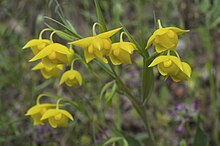Calochortus amabilis
| Calochortus amabilis | |
|---|---|
 |
|
| Scientific classification | |
| Kingdom: | Plantae |
| (unranked): | Angiosperms |
| (unranked): | Monocots |
| Order: | Liliales |
| Family: | Liliaceae |
| Genus: | Calochortus |
| Species: | C. amabilis |
| Binomial name | |
|
Calochortus amabilis Purdy |
|
Calochortus amabilis (syn. C. pulchellus var. amabilis) is a species of the genus Calochortus in the family Liliaceae. It is also known by the common names Diogenes' lantern,yellow globe-tulip,golden globe-tulip,yellow globe lily,golden fairy lantern,golden lily-bell,Chinese lantern, and short lily.
The plant is endemic to northern California, north of the San Francisco Bay Area. It grows in the Northern California Coast Ranges and Klamath Mountains, from 100 metres (330 ft)–1,000 metres (3,300 ft)–1,500 metres (4,900 ft)in altitude. It is a common member of the scrub and woodland flora, found on dry slopes in California oak woodland and chaparral habitats. Soil types vary, from the nearly solid serpentine rock to yellow clay. Natural habitat is quite wet, with 75cm or more of rain per year, followed by a dry, hot summer. Winters are cool but not frigid (USDA zones 8-9). The growing season is from midwinter to the April-May-June flowering and seed set. The plant is dormant from mid-June to November.
Common understory plant associates are Calochortus luteus, Clarkia unguiculata and Delphinium variegatum.
Calochortus amabilis is a bulbous perennial herb producing an upright, somewhat waxy branching stem to heights between 10 and 50 centimeters. The leaf at the base of the stem is flat, waxy, and narrow in shape, reaching up to 50 centimeters long and not withering away at flowering.
The inflorescence bears two or more heavily nodding flowers, each with spreading pointed yellow sepals and brown-speckled yellow petals. The inside of the petals is waxy and coated in small hairs. The fruit is a winged capsule up to three centimeters long containing dark brown seeds.
...
Wikipedia
